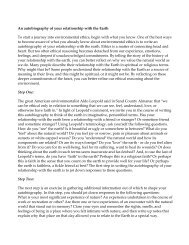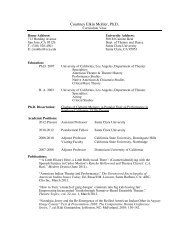ciadoncha; ¡cuántos recuerdos - Webpages at SCU - Santa Clara ...
ciadoncha; ¡cuántos recuerdos - Webpages at SCU - Santa Clara ...
ciadoncha; ¡cuántos recuerdos - Webpages at SCU - Santa Clara ...
Create successful ePaper yourself
Turn your PDF publications into a flip-book with our unique Google optimized e-Paper software.
I had the opportunity to talk with the women who had all their children in the<br />
town, with others who had one or two there and her other children in the city, and with<br />
one who did not have any of her children in the town, but all of them in the city. This is<br />
intim<strong>at</strong>ely rel<strong>at</strong>ed to the facilities of transport<strong>at</strong>ion th<strong>at</strong> were developing.<br />
Before the 60s, the majority of the women had their children in the town. Th<strong>at</strong> is<br />
if there weren’t any complic<strong>at</strong>ions and they had to take her to the city as an emergency.<br />
After the 60s, the women had a medical gynecologist who examined them<br />
regularly, almost always in Burgos. But if their labor began in the town, they had to do<br />
without him because the distance was too much- taking into account th<strong>at</strong> there were no<br />
appropri<strong>at</strong>e vehicles to notify him. We must remember th<strong>at</strong> the automobile first came to<br />
Ciadoncha in 1946, but it was not used with the liberty as we use it in the year 2000. In<br />
order to call the doctor, they used bicycles or a tractor.<br />
In the 40s and 50s, it was very difficult to find someone who would go call the<br />
doctor in the neighboring town. Many times f<strong>at</strong>her Antonio, the priest, would go get him<br />
in his car, but sometimes he could not arrive in time to <strong>at</strong>tend to the woman.<br />
The elders explained to me th<strong>at</strong> they had to prepare all the things th<strong>at</strong> were going<br />
to be needed during the labor and had to have them ready for when their labor began. For<br />
many of them, their labor began while they were working in the field and others in their<br />
house. For the participants who had their children in the 40s or 50s, preparing<br />
themselves consisted of cleaning the scissors and having the bows or ribbons ready to tie<br />
and cut the umbilical cord, preparing the blankets and diapers in such a way th<strong>at</strong> they<br />
would be <strong>at</strong> hand if the labor occurred during a cold time.<br />
From the moment the women reached their seventh month of pregnancy, they<br />
began preparing the newborn’s clothes and kept it ready so th<strong>at</strong> it could be used <strong>at</strong> any<br />
moment. Still today some women remember how they would he<strong>at</strong> the child’s clothes in<br />
the wood burning ovens so th<strong>at</strong> it wouldn’t be too cold when they used it to dress the<br />
child for the first time.<br />
The majority concurred th<strong>at</strong> it was the first birth th<strong>at</strong> was the most difficult, but<br />
with the second they knew better wh<strong>at</strong> to do because they could predict wh<strong>at</strong> would<br />
happen, and with the third they no longer felt fear and saw it as a very n<strong>at</strong>ural experience.<br />
In the 40s, there were women who had up to 16 children, of which only some lived; even<br />
so, in those times families were numerous.<br />
The husband’s presence during the labor is also something th<strong>at</strong> has changed over<br />
time. Some participants, who had their children in the 40s and 50s, told me th<strong>at</strong> they<br />
were present in the room with their wife, giving her encouragement. One of them<br />
expressed the following, which made me think of the profound love th<strong>at</strong> there is between<br />
this couple: “How could I not be with her? She continued to be my woman and I had to<br />
accompany her during these moments.”<br />
97













